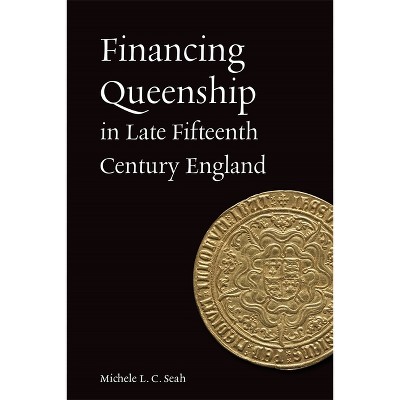Sponsored

The Erard Grecian Harp in Regency England - by Panagiotis Poulopoulos (Paperback)
$36.99
In Stock
Eligible for registries and wish lists
Sponsored
About this item
Highlights
- Winner of the Deutsches Museum Research Publication Prize 2023.
- Author(s): Panagiotis Poulopoulos
- 318 Pages
- Music, Musical Instruments
Description
About the Book
During the early nineteenth century, the harp was transformed into a sophisticated instrument that became as popular as the piano. This was largely the result of the harp's intensive technical, musical and visual upgrading, which gradually led to the transition from the single- to the double-action pedal harp. A major figure in this process was Sâebastien Erard (1752-1831), a tireless inventor and prolific manufacturer of harps and pianos operating branches in Paris and London. With the introduction in 1811 of the so-called 'Grecian' model, the first commercially built double-action harp, the Erard firm managed to establish the harp not only as a novel, state-of-the-art instrument, but also as a powerful symbol of luxury, wealth and status.0Drawing upon a wide variety of primary sources, including surviving instruments, archival documents and iconographical evidence, this book provides a comprehensive overview of the development, production and consumption of the Erard Grecian harp in Regency England. The innovative approaches employed by the Erard firm in the manufacture and marketing of harps are measured against competitors but also against the work of leading entrepreneurs in related trades, ranging from the mechanical devices and precision tools of James Watt, Henry Maudslay or Jacques Holtzapffel, through the ornamental pottery of Josiah Wedgwood, to the clocks and watches of George Prior or Abraham-Louis Breguet. In addition, the book examines the omnipresent role of the harp in the education, art, fashion and literature of the Regency era, discussing how the image and perception of the instrument were shaped by groundbreaking advances, such as the Industrial Revolution, Neoclassicism, and the Napoleonic Wars.Book Synopsis
Winner of the Deutsches Museum Research Publication Prize 2023. During the early nineteenth century, the harp was transformed into a sophisticated instrument that became as popular as the piano. This was largely the result of the harp's intensive technical, musical and visual upgrading, which gradually led to the transition from the single- to the double-action pedal harp. A major figure in this process was Sébastien Erard (1752-1831), a tireless inventor and prolific manufacturer of harps and pianos operating branches in Paris and London. With the introduction in 1811 of the so-called 'Grecian' model, the first commercially built double-action harp, the Erard firm managed to establish the harp not only as a novel, state-of-the-art instrument, but also as a powerful symbol of luxury, wealth and status. Drawing upon a wide variety of primary sources, including surviving instruments, archival documents and iconographical evidence, this book provides a comprehensive overview of the development, production and consumption of the Erard Grecian harp in Regency England. The innovative approaches employed by the Erard firm in the manufacture and marketing of harps are measured against competitors but also against the work of leading entrepreneurs in related trades, ranging from the mechanical devices and precision tools of James Watt, Henry Maudslay or Jacques Holtzapffel, through the ornamental pottery of Josiah Wedgwood, to the clocks and watches of George Prior or Abraham-Louis Breguet. In addition, the book examines the omnipresent role of the harp in the education, art, fashion and literature of the Regency era, discussing how the image and perception of the instrument were shaped by groundbreaking advances, such as the Industrial Revolution, Neoclassicism, and the Napoleonic Wars.Review Quotes
By bringing together a large number of new sources from British archives, Poulopoulos succeeds in vividly tracing not only the extraordinary music-historical significance but also the social developments of the time. In this way, the history of technology, the history of instruments and the social portrait of London society around 1800 are closely interwoven in the gripping narrative.-- "DEUTSCHES MUSEUM PUBLICATION PRIZE COMMITTEE"
Dimensions (Overall): 9.21 Inches (H) x 6.14 Inches (W) x .67 Inches (D)
Weight: .98 Pounds
Suggested Age: 22 Years and Up
Sub-Genre: Musical Instruments
Genre: Music
Number of Pages: 318
Publisher: Boydell Press
Theme: Strings
Format: Paperback
Author: Panagiotis Poulopoulos
Language: English
Street Date: June 13, 2023
TCIN: 1002561362
UPC: 9781783277728
Item Number (DPCI): 247-14-3904
Origin: Made in the USA or Imported
If the item details aren’t accurate or complete, we want to know about it.
Shipping details
Estimated ship dimensions: 0.67 inches length x 6.14 inches width x 9.21 inches height
Estimated ship weight: 0.98 pounds
We regret that this item cannot be shipped to PO Boxes.
This item cannot be shipped to the following locations: American Samoa (see also separate entry under AS), Guam (see also separate entry under GU), Northern Mariana Islands, Puerto Rico (see also separate entry under PR), United States Minor Outlying Islands, Virgin Islands, U.S., APO/FPO
Return details
This item can be returned to any Target store or Target.com.
This item must be returned within 90 days of the date it was purchased in store, shipped, delivered by a Shipt shopper, or made ready for pickup.
See the return policy for complete information.












